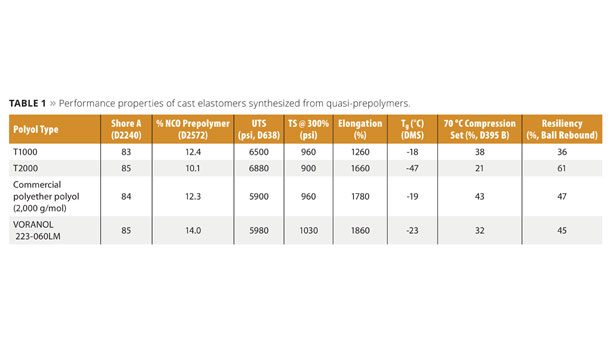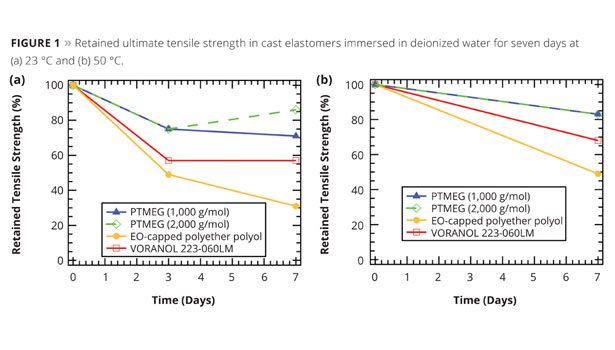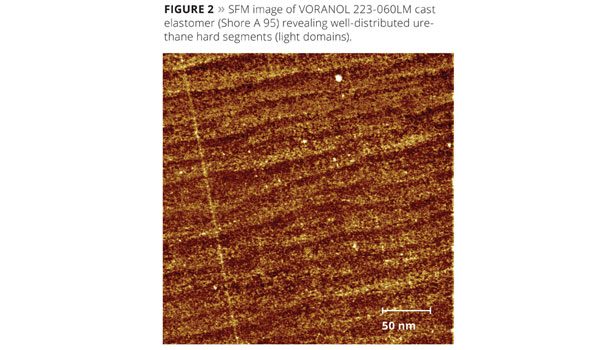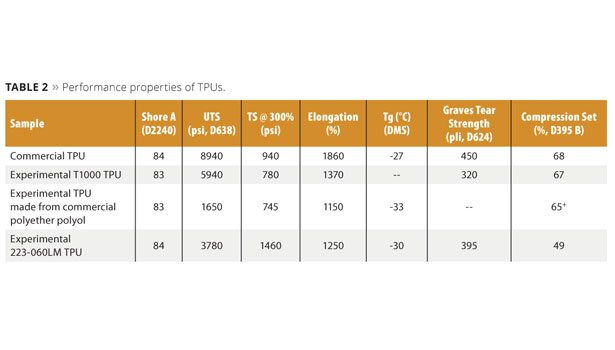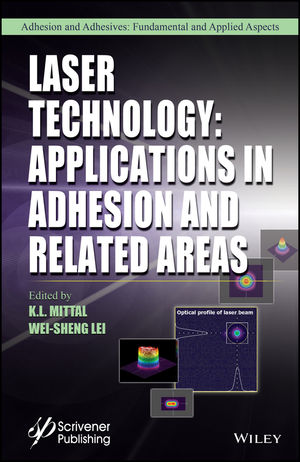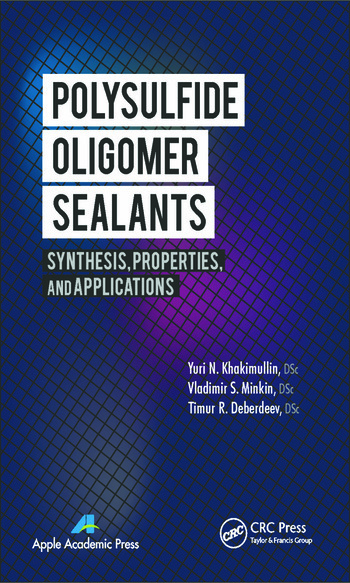The development of poly (propylene glycol) (PPG) polyether polyols with low unsaturation has attracted recent attention to partially or fully replace poly (tetramethylene ether glycols) (PTMEG) in coatings, adhesives, sealants, elastomers (CASE) and thermoplastic polyurethanes (TPUs). The loss of material performance in conventional PPG-based polyurethanes for CASE and TPU applications compared to PTMEG-based systems is well established and is attributed to a lack of strain-induced crystallization in soft segments comprised of PPG, and the presence of unsaturation at chain ends in conventional PPG polyols, leading to reduced network formation. VORANOL™ 223-060LM, from Dow, is a newly developed polyether polyol that delivers liquid processing at room temperature, low unsaturation and optimized extent of microphase separation from conventional urethane hard segment chemistries. The performance of VORANOL 223-060LM has been benchmarked against that of PTMEG- and alternative PPG-based polyether polyols in cast elastomers and TPUs with respect to reactivity, tensile properties, hysteresis, dynamic mechanical spectroscopy (DMS) and elevated temperature compression set. Cast elastomers and TPUs based on VORANOL 223-060LM polyol were observed to deliver material performance comparable to PTMEG-based systems and comparable to or exceeding alternative PPG-based polyether polyols.
Experimental
Cast elastomers were prepared from quasi-prepolymers synthesized at 60 °C (2 h) using ISONATE™ 125M/143L and benzoyl chloride (stability). The prepolymer was combined with a curative comprised of 1, 4-butanediol, polyol, and catalyst (1.05 index), cast into a heated, open mold at 80-90 °C, de-molded in <5 min, and subsequently post-cured at 80 °C for 16 h.
TPUs were synthesized using a one-shot procedure. Polyol, 1,4-butanediol, ISONATE 125M, and a Lewis acid catalyst were combined in stoichiometric ratios (1.05 index) in a Haake PolyLab QC™ mixer and allowed to react for several minutes at high temperature (170-190 °C). The TPU sample was removed and compression molded into plaques for material property evaluation.
Product Attributes
VORANOL 223-060LM is a low-viscosity, room-temperature liquid (300 ± 15 mPa·s, 25 °C, ASTM D4878) with an OH number of 61 ± 2 mg/g (ASTM D4274D). The polyol is fully miscible (>14 d) with commonly used polyether polyols, such as PTMEG, and can be utilized in a wide variety of CASE and TPU applications. The polyol exhibits reactivity comparable to PTMEG due to high primary hydroxyl content. Production cost savings can be achieved by enabling fast cure, reduced process cycle times and decreased processing temperatures. Furthermore, this polyol enables the creation of CASE and TPU products with excellent mechanical properties due to its low monol content.
Results and Discussion
In Table 1, the performance properties of cast elastomers prepared from VORANOL 223-060LM are compared to that of 1,000 g/mol PTMEG (T1000), 2,000 g/mol PTMEG (T2000), and a commercially available polyether polyol (2,000 g/mol). The prepolymer %NCO and hard segment fraction were adjusted to achieve elastomers of constant Shore A. VORANOL 223-060LM-based elastomers exhibit ultimate tensile strengths (UTS) and tensile strength at 300% elongation (TS @300%) approaching that of PTMEG-based elastomers along with improved elongation at break. The glass transition temperature, Tg, of VORANOL 223-060LM-based elastomers (-23 °C) is consistent with that of elastomers produced from T1000 (-18 °C). The commercial polyether polyol (-19 °C) reveals similar low-temperature flexibility, while the T2000-based cast elastomers had a Tg of -47 °C. In comparison to T1000-based cast elastomers, those produced from VORANOL 223-060LM exhibited improvements in compression set (ASTM D395 B, 70 °C, 25%, 24 h) (32% vs. 38%) and resiliency (Dow method, ball rebound) (45% vs. 36%), but were deficient in performance relative to the T2000-based cast elastomers.
In Figure 1, the retained UTS of cast elastomers immersed in deionized water for seven days is presented for samples aged at 23 and 50 °C. Each of the samples based on a PTMEG backbone (T1000 and T2000) exhibit the highest degree of retained UTS amongst the backbone chemistries evaluated; however, elastomers synthesized from VORANOL 223-060LM show significantly improved retained UTS compared to the PPG-based commercial polyether polyol at both temperatures. As can be anticipated from this data set, the VORANOL 223-060LM-based elastomers absorb less water over a seven-day immersion period (6.5% at 23 °C and 4.5% at 50 °C) compared to the PPG-based commercial polyether polyol (22.5% at 23 °C and 10.0% at 50 °C). The overall suite of physical properties achievable in VORANOL 223-060LM-based elastomers makes this new product offering an attractive component for developing high-performance, cost-effective polyurethane CASE systems.
The homogenous microstructure of the new polyol-based cast elastomers leads to exceptional performance achieved through polyol design, striking a balance between reactivity and phase separation between the hard and soft segments. In Figure 2, urethane hard segment domains (light) with a characteristic length scale on the order of 10 nm are evident in the image obtained using scanning force microscopy (SFM) on a Shore A 95 VORANOL 223-060LM cast elastomer. The homogenous microstructure, along with high molecular weight achievable due to low monol content in VORANOL 223-060LM, leads to the balance of performance properties presented in Table 1.
In Table 2, the performance properties of TPUs prepared from VORANOL 223-060LM are compared to that of a commercially available TPU resin and experimentally produced TPUs based on 1,000 g/mol PTMEG (T1000) and a commercially available polyether polyol (2,000 g/mol). In all cases, the hard segment fraction was adjusted to achieve TPUs of constant Shore A. The experimental T1000 TPU provides an important reference point versus the commercially available TPU to illustrate the extent of property loss related to batch synthesis in the Haake PolyLab QC mixer versus industrially practiced reactive extrusion. The UTS of VORANOL 223-060LM-based TPUs is 64% of that of the experimental T1000 TPU, primarily due to the absence of strain-induced crystallization present at high elongation in experimental VORANOL 223-060LM TPUs. However, the aforementioned TPUs possess higher TS @300% elongation (1460 psi) compared to both the experimental T1000 (780 psi) and commercial polyether polyol (745 psi) TPUs. The glass transition temperature, Tg, of VORANOL 223-060LM-based (-30 °C) is consistent with the commercial TPU (-27 °C) and the TPU made from a commercial polyether polyol (-33 °C), suggesting that all samples possess similar low-temperature flexibility. In comparison to experimental T1000-based TPUs, TPUs synthesized from VORANOL 223-060LM exhibit improved tear strength (ASTM D624) and 70 °C compression set (ASTM D395 B, 70 °C, 25%, 24 h) due to the optimized urethane microstructure achievable with the new polyol.
In Figure 3, tensile hysteresis and 150 °C creep resistance are compared for experimental TPUs produced from T1000, the commercial polyether polyol, and VORANOL 223-060LM. Tensile hysteresis measurements were performed at 300% elongation with no relaxation time between extension/relaxation cycles using ASTM D638 Type 5 tensile specimens (Figure 3a). Energy loss (%) is measured as the difference in area under the extension and relaxation stress-strain profiles and corresponds to non-elastically recovered energy losses within the sample due to energy dissipative mechanisms. Energy loss is recorded as a function of the number of times the sample is placed under load (cycle number). For all sample types, the measured hysteresis energy loss reaches an asymptotic value with increasing cycle number. The VORANOL 223-060LM TPU exhibits tensile hysteresis performance between that of the experimental T1000 and commercial polyether polyol TPUs after a single deformation cycle, and matches the performance of the experimental T1000 TPU for subsequent deformation cycles. In Figure 3b, 150 °C creep resistance (50 g load, 24 h) for the commercial TPU, experimentally produced T1000, and VORANOL 223-060LM TPUs is shown. While both the commercial TPU and experimentally produced T1000 TPU undergo mechanical failure at <0.1 h (36 s), the VORANOL 223-060LM-based TPU exhibits remarkable dimensional stability (<4% change in length) over a 24 h period due to the increased hard segment temperature stability compared to competitive benchmarks. These findings suggest the high performance potential of VORANOL 223-060LM-based TPUs in applications in which the TPU is subjected to repeated mechanical stresses, or in which high temperature performance is required.
Conclusions
VORANOL 223-060LM is a new high-performance, cost-effective polyol for polyurethane CASE and TPU applications. The combination of low viscosity at room temperature and high primary hydroxyl content can reduce production costs by making possible fast cure, reduced process cycle times, and decreased processing temperatures. The material performance of the new polyol-based cast elastomers and TPUs has been benchmarked against that of analogous PTMEG and alternative PPG-based polyether polyols in cast elastomers and TPUs, and shown to deliver material performance comparable to PTMEG-based systems and comparable to or exceeding alternative PPG-based polyether polyols due to the low monol content and optimized microstructure realizable in VORANOL 223-060LM-based polyurethane products.
Acknowledgements
We thank Mark Ahearn, Robert Cieslinski, Brian Nickless, Joe Phillips, Carl Reinhardt, Matthias Schaefer, Nick Shurgott, Chris Thiede, and Ben Wendt for useful discussions, support, and/or experimental assistance.
For more information and product samples, contact Juan Carlos Medina (jmedina@dow.com) or Chris Thiede (cthiede@dow.com).
™ Trademark of The Dow Chemical Company (“Dow”) or an affiliated company of Dow

